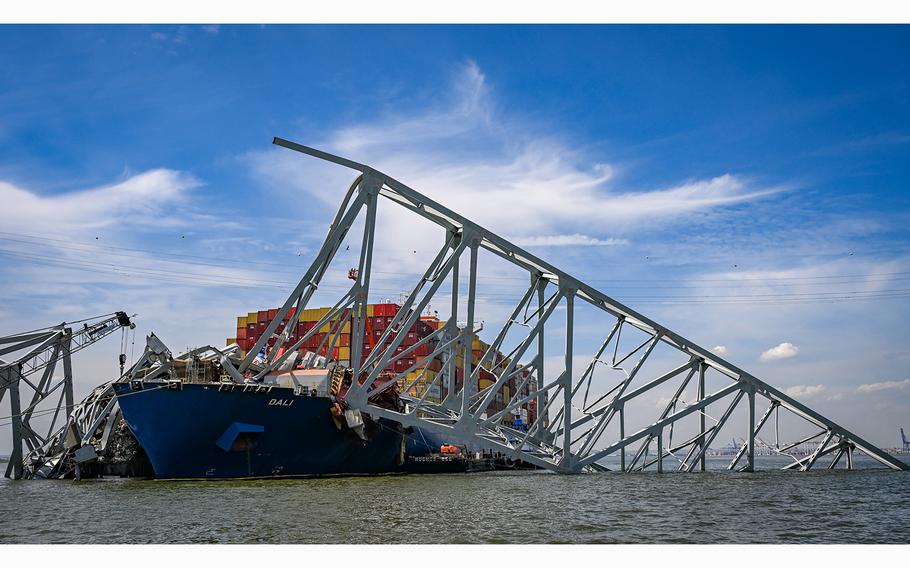
Salvage efforts continue as workers make preparations to remove the wreckage of the Francis Scott Key Bridge from the container ship Dali five weeks after the catastrophic collapse. (Jerry Jackson/The Baltimore Sun/TNS)
BALTIMORE (Tribune News Service) — Maryland transportation officials said Thursday that they expect to replace the Francis Scott Key Bridge with a new span in just over four years.
The project to replace the span of Interstate 695 by fall of 2028 is estimated to cost between $1.7 and $1.9 billion, Maryland Transportation Secretary Paul Wiedefeld said Thursday.
Plans to replace the 1.6-mile bridge have been in flux since the span collapsed into the Patapsco River early March 26, when a support column was struck by a massive cargo ship, killing six construction workers. Experts initially estimated it’d take between two and 15 years to replace the bridge, which closed the loop of the Baltimore Beltway when it opened in 1977.
The cost estimate is preliminary, with detailed engineering specifics not confirmed, Wiedefeld said in a phone interview. A major caveat in the timeline will be going through the bidding process, too. The rebuild will be a “progressive design-build” project, meaning the selected contractor will hire a designer and plan steps along the way, to “get this thing open as quickly as possible,” Wiedefeld said.
The new bridge is expected to be paid for either mostly or entirely with federal funds, with Maryland’s entire congressional delegation putting forth legislation to ensure the federal government covers all costs.
Maryland Gov. Wes Moore was slated to discuss funding with House lawmakers Thursday morning in Washington.
Democratic President Joe Biden has pledged for the federal government to pay for the entire response, committing to moving “heaven and earth to rebuild this bridge as rapidly as humanly possible” while visiting the collapse site last month. His administration has started that process by releasing an initial $60 million in emergency relief funds to Wiedefeld’s department.
The federal government, in turn, will get some relief from a $350 million payout from Chubb, the state’s insurance provider for the Key Bridge, Wiedefeld confirmed, saying that the money would be directed to the federal government as part of a condition of the Federal Highway Administration’s emergency relief program, which is funding the bulk of the bridge rebuild.
Until Thursday, most considerations on the new bridge were hypothetical, with officials largely focused on clearing the nearly 50,000 tons of steel and concrete from the path of the bridge that has blocked the Port of Baltimore to most vessel traffic. Crews were still in the water Thursday trying to clear the wreckage of the old bridge from the river and locate the last of the six construction workers who were killed in the collapse.
Officials said earlier this week that they are focused on removing sections of steel off the Dali in an effort to refloat the giant freighter, which is more than three football fields long and remains stuck aground on the side of the harbor’s main channel. While alternate channels are allowing larger vessels each week, the main 50-foot channel is still expected to open around the end of this month.
The Maryland Transportation Authority, which oversees the bridge, will be holding a virtual forum May 7 with the construction industry as the agency develops a formal request for proposals.
Until the new bridge is open, the state will continue to work on strategies to relieve traffic issues that have stemmed from the bridge collapse, such as rush hour congestion hitting the two tunnels that cross the Baltimore Harbor.
©2024 The Baltimore Sun.
Visit at baltimoresun.com
Distributed by Tribune Content Agency, LLC.